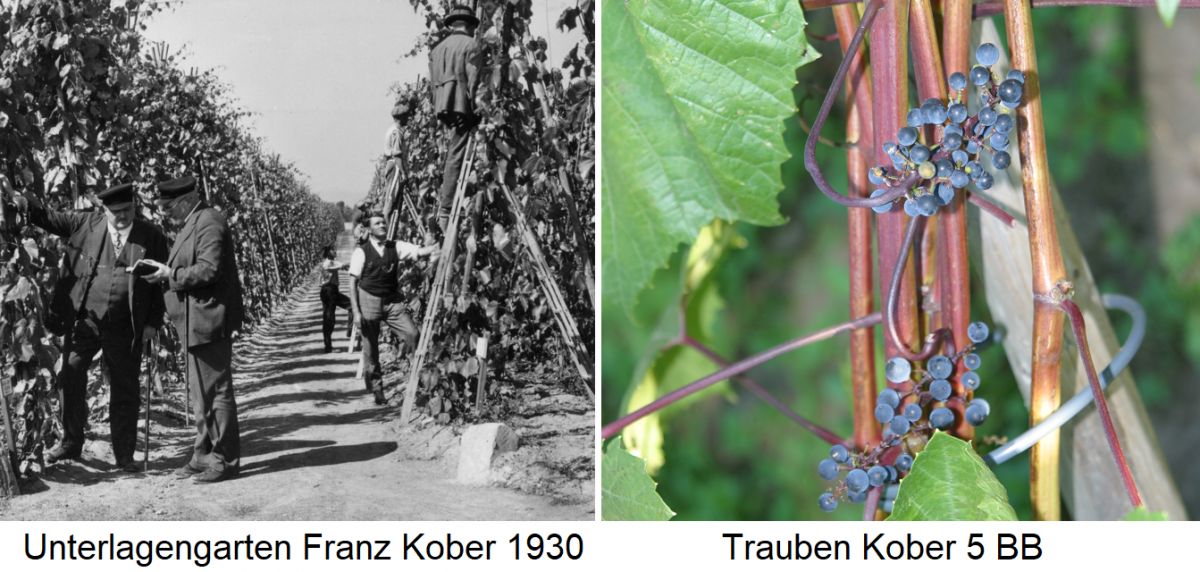The famous rootstock vine is an interspecific new variety between American wild vines of the species Vitis berlandieri x Vitis riparia; it is an all-female variety. Synonyms are 5 BB, 5 BB Selection Kober, Berlandieri x Riparia Kober 5 BB, C-25, Craciunel 25, Kober, Kobera 5 BB, Kobravka, Selektsii Kobera, Teleki 5 BB and Teleki Kober 5 BB. It is one of the first phylloxera-resistant rootstocks to achieve worldwide significance and is still used today in many countries in the form of various clones. Its history shows how time-consuming and complex the breeding of new vines is and how carefully and precisely it has to be done. All breeding processes must be meticulously documented.

Zsigmond Teleki
The Hungarian vineyard owner Zsigmond Teleki (1854-1910) was not satisfied with the rootstock vines he was using, such as Solonis, and had learnt that the wild vine Vitis berlandieri and its hybrids were excellently suited to limestone soils. He obtained 22 pounds of seeds from the vine nursery operator Euryale Rességuier. The reason for this was that the movement of vine cuttings was severely restricted, at least between individual countries, due to the phylloxera catastrophe that was at its peak. Teleki planted around 40,000 seedlings on the vineyards of his business in Villány. He believed that he had received only pure Vitis berlandieri, but it turned out that only 10 berlandieri seedlings and the majority were hybrids from crosses between Vitis berlandieri x Vitis riparia, Vitis berlandieri x Vitis rupestris and others.
Franz Kober
The Berlandieri riparia hybrids selected by Teleki later formed the basis for the rootstocks Kober 125 AA, Kober 5 BB, Teleki 5 A (identical to Kober 5 BB according to the descendant Andor Teleki), Teleki 5 C, Teleki 8 B and SO 4 (selection Oppenheim 4). In 1904, Franz Kober (1864-1943), a friend of Teleki's, commissioned him to send him cuttings of every distinct type of Berlandieri x Riparia to Austria (then still the Habsburg Empire). Kober planted these cuttings in a plot of land leased from the Ministry of Agriculture on the Nußberg near Vienna (Austria). Kober made a selection beforehand. He had selected 50 types in four groups, which he labelled A, B, C and D. The groups were assigned according to morphological aspects (shape and appearance).
Naming
From around 100 plants, Kober selected particularly robust and vigorous plants, which he labelled with a double letter. This is how the Kober 5 BB got its name, as the 5th vine of the BB group ultimately proved to be the best for the Austrian site conditions. Kober now had this (only) vine propagated vegatively in the vine nursery in Wiener Neustadt. In 1920, 16 years after the start of the project, he presented it to the public. This was relatively quick, as it often takes several decades for a new grape variety or rootstock to be authorised.
Kober had concealed the origin of Teleki and labelled it the "Kober vine". However, Sigmund Teleki had already made the fundamental (and also very important) basic selection. Both breeders made the mistake of marketing very similar types with the same number designation in mixed form. In the individual wine-growing countries, a series of selections were made from this mixture. Ferdinand Reckendorfer, director of the Krems School of Viticulture (Lower Austria), selected the rootstocks R(eckendorfer) 7, R 27, R 43 and 8-35 from Kober 5 BB, while the German biologist Dr Carl Börner (1880-1953) selected 59 B(örner), 65 B and 68 B. However, none of these selections achieved any significance. The Austrian viticulturalist Josef Mader (1876-1938) in particular was in favour of a broad use of the rootstock.
Characteristics
Resistance to phylloxera root lice is good. Although it is susceptible to phylloxera, this does not play a role as a rootstock (but it does play a role in propagation). It tolerates limestone soils and drought well. The semi-deep-rooted vine is vigorous, which also has an effect on the upper part. It is resistant to chlorosis, but less suitable for varieties that tend to coulure. Today, various clones of Kober 5 BB are marketed after phytosanitary inspection (plant health certificate). The rootstock is used in many countries.
Picture left: By unknown, postcard Geisenheim, GFDL 1.2, link
Image on the right: By Joachim Schmid, Geisenheim, CC BY 3.0 de, Link
Voices of our members

In the past, you needed a wealth of encyclopaedias and specialist literature to keep up to date in your vinophile professional life. Today, Wine lexicon from wein.plus is one of my best helpers and can rightly be called the "bible of wine knowledge".
Prof. Dr. Walter Kutscher
Lehrgangsleiter Sommelierausbildung WIFI-Wien